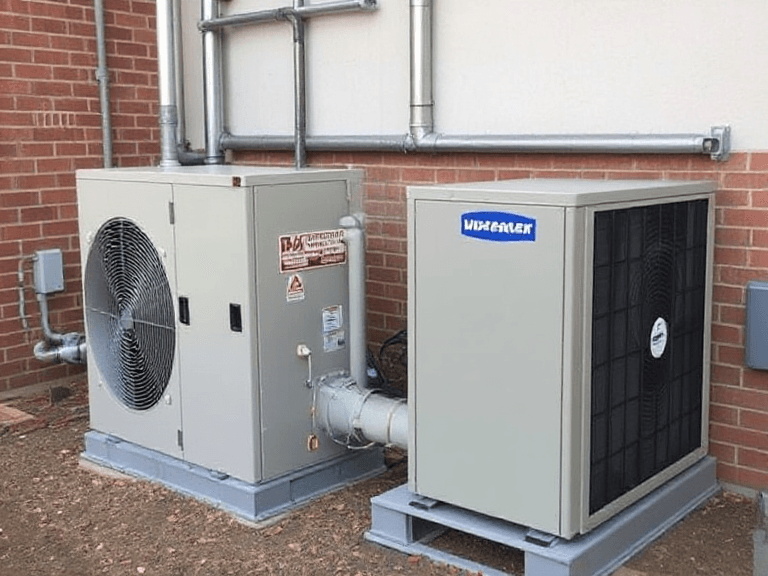When it comes to optimizing the performance and efficiency of your HVAC system, the proper installation of a compressor and air handler is crucial. These two components work together to regulate your home’s temperature, ensuring comfort throughout the year. At ZZ the HandyMan, we pride ourselves on delivering top-notch installation services to make your HVAC system run like a dream. In this guide, we’ll walk you through the essentials of compressor and air handler installation, common challenges, and the benefits of professional service.
What is an HVAC Compressor?
The compressor is the heart of your HVAC system. It compresses refrigerant gas, raising its temperature and pressure before sending it to the condenser coil. This process allows heat to be released outside during cooling mode and absorbed inside during heating mode. A properly installed compressor ensures your HVAC system operates efficiently and lasts for years.
What is an Air Handler?
The air handler, on the other hand, is responsible for circulating conditioned air throughout your home. It contains essential components like a blower, heating or cooling elements, and filters. Paired with the compressor, the air handler plays a vital role in maintaining consistent airflow and indoor comfort.
The Importance of Professional Installation
Installing a compressor and air handler is a complex task that requires expertise, precision, and the right tools. Improper installation can lead to reduced system efficiency, increased energy costs, and frequent breakdowns. Here are some reasons why professional installation matters:
- Correct Sizing: Professionals ensure that the compressor and air handler are appropriately sized for your home’s heating and cooling needs.
- Proper Placement: The placement of the compressor affects its efficiency and longevity. Similarly, air handlers need to be installed in areas with adequate ventilation.
- System Compatibility: Ensuring the compressor and air handler are compatible with each other and with the existing HVAC system prevents operational issues.
- Safety: HVAC systems involve electrical components and refrigerants, which can be hazardous if mishandled.
- Warranty Compliance: Many manufacturers require professional installation to honor warranties.
Steps for Compressor Installation
- Site Preparation: The installation area must be level, clean, and free of debris. For outdoor compressors, this often involves preparing a concrete pad.
- Electrical Connections: Professionals connect the compressor to the power supply, ensuring all electrical components meet safety standards.
- Refrigerant Line Connection: The refrigerant lines are connected to the compressor and tested for leaks.
- Testing and Calibration: After installation, the system is tested to ensure proper functionality and efficiency.
Steps for Air Handler Installation
- Selecting the Location: The air handler is typically installed in a central location, such as an attic, basement, or utility closet.
- Mounting: The unit is securely mounted to reduce vibration and noise during operation.
- Ductwork Connection: The air handler is connected to the home’s ductwork to distribute air evenly.
- Electrical and Refrigerant Connections: The air handler is wired and connected to the refrigerant lines.
- Filter and Drain Installation: Filters and condensate drains are installed to ensure clean air circulation and proper moisture removal.
- Testing: Like the compressor, the air handler is tested for performance and efficiency.
Common Challenges in Installation
- Incorrect Sizing: Installing a system that’s too large or too small can lead to inefficiency and premature wear.
- Poor Refrigerant Line Connections: Leaks in the refrigerant lines can reduce system efficiency and increase energy costs.
- Inadequate Insulation: Insufficient insulation around the air handler can lead to energy loss.
- Improper Drainage: Faulty condensate drains can cause water damage and mold growth.
Benefits of a Professional Installation by ZZ the HandyMan
- Energy Efficiency: Proper installation ensures your HVAC system operates at peak efficiency, lowering energy bills.
- Enhanced Comfort: With a correctly installed system, you’ll enjoy consistent indoor temperatures year-round.
- Reduced Repairs: Professional installation minimizes the risk of frequent breakdowns and costly repairs.
- Longevity: A well-installed compressor and air handler will last longer, providing better value for your investment.
- Peace of Mind: Knowing your HVAC system was installed by experts means fewer worries about unexpected issues.
Maintenance Tips After Installation
Once your compressor and air handler are installed, regular maintenance is essential to keep them running smoothly. Here are some tips:
- Change Filters Regularly: Dirty filters reduce airflow and strain the system.
- Inspect Refrigerant Levels: Low refrigerant levels can lead to inefficient cooling or heating.
- Clean the Outdoor Unit: Remove debris and ensure proper airflow around the compressor.
- Schedule Annual Tune-Ups: Professional maintenance checks can identify and fix potential issues before they become major problems.
Why Choose ZZ the HandyMan?
At ZZ the HandyMan, we understand that every home has unique HVAC needs. Our team of skilled professionals is equipped to handle all aspects of compressor and air handler installation with precision and care. Here’s what sets us apart:
- Expert Technicians: Our technicians are trained and experienced in HVAC installations.
- Transparent Pricing: We provide upfront quotes with no hidden fees.
- Customer Satisfaction: We’re committed to ensuring your comfort and satisfaction.
- Comprehensive Services: From installation to maintenance, we’ve got you covered.
Conclusion The installation of a compressor and air handler is a critical step in ensuring your HVAC system performs efficiently and reliably. By trusting the professionals at ZZ the HandyMan, you’re investing in quality, comfort, and peace of mind. Contact us today to schedule your installation and experience the difference of professional service!


